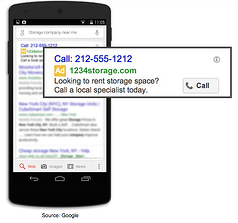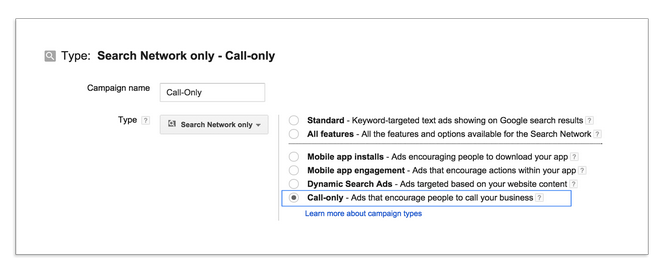Call-Only Campaigns Offer New Mobile Conversion Possibilities
Allison Casey Digital Marketing Director, Partner#Digital Marketing, #Inbound Marketing, #SEO

Learn when you should use Google's new call-only campaigns, which allow people to call you directly from search results pages.

We have gone on record as not being huge fans of clients investing all of their marketing budget in pay-per-click (PPC) ads as the only way to generate site traffic and leads. Instead, we recommend using Search Engine Optimization (SEO) techniques to drive organic traffic to your site. However, for some clients, PPC is a great way to drive immediate traffic if their sales funnel is completely dry and there is a business critical need to get the lead flow going rapidly.
We all know that being found in search engine results pages is critical to success with organic traffic and, ideally, well targeted content for the right kind of organic traffic. But when that traffic comes from mobile searches, it’s even more critical, as 70 percent of people searching on mobile will call a business directly from the search results.*
Now, with Google’s launch of call-only campaign options for Google AdWords, businesses that are more phone call conversion focused or have high mobile traffic (home repair services, restaurants, etc.) might want to try allocating some of their marketing dollars to a targeted PPC spend.
What makes the call-only campaign options compelling is that they are specifically designed to only display on mobile devices that can make phone calls. This means that every click you pay for can be a phone call to your business.

Previously, advertisers were able to set up call-only ads with call extensions, but the new option means it is easier to measure calls as the only conversion type for a campaign. This gives you better metrics as to whether or not your PPC campaign is actually driving leads to your business.
However, just as in regular PPC ads, your copy plays a vital part of actually getting the click (or now, the call). You’ll want to keep the following strategies in mind for using Call-Only ads:
- Messaging should reflect that a person is calling, not going to a website, e.g. “Call us for a quote” or “Talk to a sales associate now”.
- Bid accordingly to how valuable a direct call is to your business. You may want to invest more in a call than you would have for a click.
- Promote services/products that people are ready to buy now. People won’t be doing research on your site with a click, they will be talking to a live person.
- Speaking of live, don’t have the click go to an automated phone system. It will defeat the purpose of the “call now” messaging.
As with all marketing programs, having a solid strategy in place, along with tight metrics and reporting so you can see what is working and make adjustments, is the key for making sure you are spending money smartly and achieving the best results. Have you experimented with call only ads? Were you successful? Do you have any other questions about PPC or local SEO? Please let us know in the comments below.
*Google/Ipsos, The Role of Click to Call in the Path to Purchase, September, 2013.
Related Posts
The Continuing Rise of Zero-Click Search (and What You Can Do About It)
In a zero-click internet search environment, your website needs to be fully-optimized for every organic click - here's what you need to do..

Generative Engine Optimization (GEO): Creating Content For AI-Search
Generative Engine Optimization (GEO) boosts your content's visibility in AI search. Discover 5 key strategies for platforms like Perplexity and Gemini.
Results Matter.
We design creative digital solutions that grow your business, strengthen your brand and engage your audience. Our team blends creativity with insights, analytics and technology to deliver beauty, function, accessibility and most of all, ROI. Do you have a project you want to discuss?
Like what you read?
Subscribe to our blog "Diagram Views" for the latest trends in web design, inbound marketing and mobile strategy.